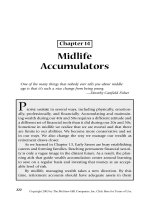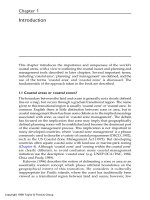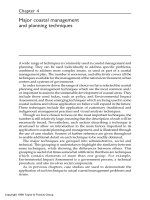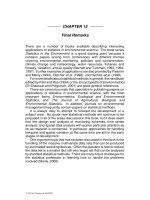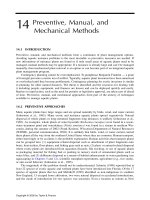NATURAL ARSENIC IN GROUNDWATER: OCCURRENCE, REMEDIATION AND MANAGEMENT - CHAPTER 14 pptx
Bạn đang xem bản rút gọn của tài liệu. Xem và tải ngay bản đầy đủ của tài liệu tại đây (80.64 KB, 6 trang )
Arsenic bioaccumulation in a green algae and its subsequent
recycling in soils of Bangladesh
Imamul Huq, Afroza Bulbul & M.S. Choudhury
Department of Soil, Water & Environment, University of Dhaka, Dhaka, Bangladesh
Shah Alam & Shigenao Kawai
Department of Agro-Bioscience, Iwate University, Morioka, Japan
ABSTRACT: A green algae (Pithophora) collected from the botanical garden of Dhaka University
were grown in vitro containing or not added arsenic (As). Arsenic application rates were 0.0, 0.05,
0.25, 0.5, and 1.0 mg/L. The algae were grown for 90 d, during which the algae received in incre-
ments the treatments of As at the specified concentration. After 90 d the algae were collected through
filtration. The collected algae were dried, pulverized, and chemically analyzed for As. The treated
algae were then added to a soil and were allowed to decompose over a period of 45 d. Soil samples
were collected at intervals of 15, 30, and 45d. The decomposition of algae to soil enrichment with
As was studied. Presence of As in the algal growth medium substantially increased the cellular As
content of algae and was contributory to soil enrichment by the element upon mineralization.
1 INTRODUCTION
Arsenic (As) in groundwater and its fate and transport in the environment have become matters of
great concern in Bangladesh. Tube-well water extracted in Bangladesh from shallow aquifers is
the primary source of drinking/cooking water for most of its population. Besides domestic use,
huge quantities of water from shallow aquifer are also used for irrigation during the dry season.
Since its detection in late 1993 in Bangladesh, much of the research works on As have focused on
its presence in and exposure through drinking/cooking water (Yousuf et al. 2001). However, wide-
spread use of groundwater for irrigation suggests that ingestion of irrigated crops could be another
major exposure route for As. Another major concern is the phytotoxicity due to increased As in
soil/water and its long-term impact on agricultural yield is another major concern (Ali et al. 2003).
Limited studies have been conducted to assess the presence of As in the food chain (Meharg et al.
2001, Huq et al. 2001, Duxbury et al. 2002, Abedin et al. 2002). The country is heavily dependent
on its agricultural sector for its gross domestic products (GDP). More than 80% of the population
depends on agriculture for its livelihood. The agricultural sector employs about 90% of rural males
as well as 80% of rural females of the country (BBS 1998). To become self-sufficient in food grain,
Bangladesh government has encouraged production of High Yielding Variety (HYV) rice, which
requires a large volume of irrigation water. The use of groundwater for irrigation has increased
abruptly over the last couple of decades. About 86% of the total groundwater withdrawn is utilized
in agricultural sector (BADC 2000). The use of As contaminated irrigation waters in Bangladesh
may cause accumulation of As in rice and rice plants and this issue needs to be examined.
Since rice is the staple food in this country, any adverse effects on nutrient content of rice due
to arsenic contaminated irrigation water would enhance the malnutrition problem although As
uptake and accumulation in rice plant from irrigation water may differ depending on cultivars used
(Abedin et al. 2002). About 40% of total arable land of our country is now under irrigation facil-
ities and more than 60% of this irrigation water come from groundwater which is extracted by deep
119
Natural Arsenic in Groundwater: Occurrence, Remediation and Management –
Bundschuh, Bhattacharya and Chandrasekharam (eds)
© 2005, Taylor & Francis Group, London, ISBN 04 1536 700 X
Copyright © 2005 Taylor & Francis Group plc, London, UK
tube-well, shallow tube-well, and hand tube well (BBS 1998). Most groundwater used for irrigation
in Bangladesh is contaminated with As (Khan et al. 1998). Twenty percent loss of crop (cereal)
production due to high concentration of As (30 mg/kg) in plant body was reported by Davis &
Coker (1979). Like other heavy metals, As is toxic to plants. In Bangladesh, Boro rice (dry season
rice) is the major recipient of irrigation water. The rapid increase in Boro production is mainly
attributed to the increase in the area under irrigation (and also use of high yielding varieties of
rice). Currently, Boro rice accounts for about 37% of the total rice production in Bangladesh (BBS
1998). Besides Boro rice, wheat and a range of other crops and vegetables cultivated during dry
season also need irrigation.
Historically, the growth of algae in rice fields has been considered a natural fertilization process
as decomposition of algae in rice fields adds nitrogen and other nutrients to the soil. The algae
growing in the rice fields are supposed to take up among others, the As present in the water. Upon
decomposition, the As thus accumulated will be mineralized and enrich the soil with the toxic elem-
ent and it is possible that the subsequent crop takes it up. This is not a desirable situation.
Keeping these views in mind, a laboratory experiment with green algae was set up with the
objectives to study the bioaccumulation of As by algae from As contaminated water and to analyze
the recycling of the bioaccumulated As.
2MATERIALS AND METHODS
2.1 Bioaccumulation of As
Seeds of green algae (Pithophora) of the Phytophthera family were collected from the Botanical
garden of Dhaka University. A stock of the algae was produced by growing them in nutrient solu-
tion of the following composition: nitrogen (24 g/L N), potassium (2.21 g/L K), and phosphorus
(8 g/L P) supplied from NH
4
Cl, KH
2
PO
4,
and CaHPO
4
, respectively (Smilde 1981). All salts used
were of Analar grade. For the culture of algae in the laboratory, 5 treatments (0, 0.05, 0.25, 0.5, and
1.0 mg/L As in water) were chosen. The As was applied from sodium meta-arsenite. Each treat-
ment was replicated 3 times. After each pot was filled with tap water and the nutrient solution, the
As solutions of different concentrations were added to them. Then 20 ml of the green algae from
the stock were transferred into each pot. The algae were cultured for 90 d receiving full sunlight
during the day to get a substantial biomass. During this period, water containing As at the speci-
fied concentration were added. As such, the treatments received a total of 0, 2.5, 12.5, 25 and
50 mg As respectively for the five treatments over 90 d of growth. This was done to keep the water
level in the pots at the same level as in the beginning of the experiment. After 90 d, the algae were
harvested carefully from the pot by filtration and were allowed to dry in air. After drying the algae
in air, these were oven-dried and dusted by a blender and the dust algae were latter used for min-
eralization process in soil. Results presented here are the averages of three individual replications.
2.2 Recycling of the elements in soil
The soils used in the present study were collected from 0–150 mm depth. The soils were non-
calcareous Grey Floodplain and represented the Dhamrai series, a Typic Haplaquept (mixed, non-
acid, silty clay). The soil samples were collected from arable land and air dried in the laboratory.
For hastening the drying it was exposed to sunlight. After drying in air, the larger aggregate were
broken gently by crushing it in a wooden mortar and passed through a 2 mm sieve. Plastic pots of
250 mL sizes, washed with detergent and rinsed with distill water and dried in sunlight, were used
for the incubation study. Each pot was filled with 100 g of dry soil and about 10 g harvested algae
were added to each pot and the soil was properly submerged with sterilized water. The soils remained
submerged with sterilized water for 45 d. All experiments were done in triplicates. Soils from each
pot were collected at an interval of 15, 30, and 45 d. The soils were dried, crushed, and stored in a
plastic bag for analysis. Results presented here are the averages of three individual replications.
120
Copyright © 2005 Taylor & Francis Group plc, London, UK
2.3 Analysis of algal samples
The algal samples were analyzed at the time of collection and after harvest for As (Jackson 1973).
Arsenic was analyzed by hydride generation atomic absorption spectrophotometric (HG-AAS)
technique. Arsenic in algae and in soil was extracted following the method of Portman & Riley
(1964). Arsenic in algae at the time of collection was not in the detectable range.
2.4 Analysis of soil sample
Soils were also analyzed before the set up of the experiments to see the nutrients status at the time
of collection. The results are presented in Table 1. Standard methods were followed for the routine
analyses of soil. Arsenic in soil was analyzed as described for algae.
3 RESULTS AND DISCUSSION
3.1 Bioaccumulation of As in algae
The bioaccumulation of As increased gradually with increasing As concentration in water (Fig. 1).
When As was absent in the solution the algae did not show detectable quantity of As. However, even
at 0.05 mg/L As in water application rate (2.5mg As) corresponding As in algae was 11.14mg/kg
and at 1.0 mg/L As treated water (50.0mg As) the algae had accumulated 53.19mg/kg As. Algae
possess the ability to take up toxic heavy metals from the environment, resulting in higher con-
centration than that in the surrounding water (Megharaja et al. 2003). Bioaccumulation studies
reveal the accumulation of contaminant in the organism via food or water containing the contam-
inant (Megharaja et al. 2003). Plants take up As
3ϩ
passively with water, but As
5ϩ
is actively taken
up by some algal species (Andreae et al. 1983). Similar high accumulation of As by a fern has been
reported by Ma et al. (2001). The regression analysis between applied As and As in algae showed
that the relationship was positive (Y ϭ 6.251 ϩ 49.287x) and highly significant (r ϭ 0.9578**).
121
Table 1. Some physical, physico-chemical, and
chemical properties of soil used during the study.
Properties Values
pH (soil:water ϭ 1:2.5) 6.28
Electrical conductivity (EC
e
) 0.07 S
Particle size analysis
Sand 6.26%
Silt 48.68%
Clay 42.05%
Texture Silty clay
Moisture content 3.8%
Organic carbon (OC) 0.8%
Organic matter (OM) 1.4%
Total nitrogen 0.12%
Total phosphorus 0.07%
Total potassium 0.32%
Total sulfur 0.17%
Available N 58.24 mg/kg
Available P 3.024 mg/kg
Available K 0.2564 meq
Available S 42 mg/kg
Arsenic (As) n.d.
Copyright © 2005 Taylor & Francis Group plc, London, UK
3.2 Recycling of As in soil
The release of As through mineralization of algae was studied at different phases of incubation
(Fig. 2). It is apparent that the algae growing on As-contaminated water and bioaccumulating it
subsequently released the element in soil during the process of mineralization. The release pattern
however, differed with days of incubation.
The release of As was maximum after 30 d of incubation followed by a decrease after 45 d of
incubation. The release of As at 15 d was the maximum in soils receiving algae treated at the rate
of 1.0 mg As/L. After 30 d of incubation the picture was little bit different. The maximum As
release was in the soil receiving algae treated with 0.5 mg/L As. It needs to be mentioned here that
the background level of As in soil was less than the detectable limit of 2 g/L. Hence, it is clear
that algae growing in environments of As contamination accumulate it and subsequently release it
to the soil. The analysis of variance (ANOVA) indicated that both algal As content as well as days
of incubation had significant positive contribution to As release in soil (F for As in algae 13.054**
and for days of incubation 10.569**, LSD
(0.95)
being 5.96).
A large fraction of this recycled As is not likely to be washed out by flood or rainwater in oxi-
dized condition due to its high affinity to iron (Fe), manganese (Mn), aluminum (Al), and other
elements in soils (Kabata-Pendias & Pendias 2001). As a result, a cumulative accumulation of As
in surface soils is expected and some recent data show As contents as high as 83 mg/kg in the top
soil of Bangladesh (Huq et al. 2003, Alam & Sattar 2000, Ullah 1998). In general, higher As contents
have been reported in the top layer of soils (Huq et al. 2001). The increased As content after 30 d
122
0
10
20
30
40
50
60
70
0 2.5 12.5 25.0 50.0
Arsenic applied in water (mg)
As content in algae, mg kg
-1
Figure 1. Content of As in algae as affected by applied As in water.
0
5
10
15
20
25
30
35
To T1 T2 T3 T4 To T1 T2 T3 T4 To T1 T2 T3 T4
As in soil, mg/kg
As in soil after 15 d
As in soil after 30 d
As in soil after 45 d
Figure 2. Mineralized As in soil from algae treated with different concentration of As (T
0
, T1, T2, T3 & T4
are 0, 0.05, 0.25, 0.5 & 1.0 mg As/L).
Copyright © 2005 Taylor & Francis Group plc, London, UK
of incubation could be due to the maximum mineralization of the added algae. The reduction in As
release after 45 d could be a phenomenon of As fixation or conversion through biomethylation.
This result also indicates that rice soils irrigated with As contaminated water, where algal growth
is a common occurrence, will accumulate As and will be taken up by the crop grown on such soils.
Arsenic concentration in algae indicated positive correlation with the As content in the soil for all
the three different phases. Correlation coefficient was high (r ϭ 0.91) for the 1st phase, whereas
the values of r for 2nd and 3rd phases were 0.41 and 0.60, respectively.
It may be concluded from the present investigation that rice fields with algal growth as a natural
phenomenon and receiving irrigation from As contaminated groundwater, are likely to have a
build up of As through nutrient recycling process. This is obviously a major concern vis-a-vis soil
pollution and contamination of the food chain through water-soil-crop transfer of contaminants.
This demands special attention so far the irrigated rice culture is concerned.
REFERENCES
Abedin, M.J., Cresser, M.S., Meharg, A.A., Feldmann, J. & Cotter-Howells, J. 2002. Arsenic accumulation
and metabolism in rice. Env. Sci. Technol. 36: 962–968.
Alam, M.B. & Sattar, M.A. 2000. Assessment of arsenic contamination in soils and waters in some areas of
Bangladesh. Water Sci. Technol. 42: 185–193.
Ali, M., Ashraf, A.B.M.B., Jalil, M.A., Delwar Hossain, M., Ahmed, M.F., Al Masud, A., Kamruzzaman, M. &
Rahman, M.A. 2003. Arsenic in plant soil Environment in Bangladesh. In M.F. Ahmed, A.M. Ashraf, &
A. Zafar (eds.): Fate of Arsenic in the Environment, p. 85–112, BUET-UNU, Dhaka.
Andreae, M.O., Byod, J.J. & Forelicj, P.N. 1983. Arsenic, Antimony, Germanium and Tin in the Jyo estuary,
Portugal-modeling a polluted estuary. Environ. Sci. Tech. 17: 731–737.
BADC 2002. Survey Report on Irrigation Equipment and Irrigated area in Boro/2001 season, Bangladesh
Agricultural Development Corporation, March 2002.
BBS 1996. Statistical Yearbook of Bangladesh, Bangladesh Bureau of Statistics, Statistics Division, Ministry
of Planning, People’s Republic of Bangladesh. p. 10.
Davis, R.D. & Coker, E.G. 1979. Proc. Int. Conf. Management and Control of Heavy Metals in the
Environment. 553 CEP Consultants Ltd. Edinburg, UK.
Duxbury, J.M., Mayer, A.B., Lauren, J.G. & Hassan, N. 2002. Arsenic content of rice in Bangladesh and
Impacts on rice productivity. 4th Annual Conference on Arsenic contamination in groundwater in
Bangladesh: Cause, Effect and Remedy, Dhaka, 12–13 January, 2002.
Huq, S.M.I., Ahmed, K.M., Sultana, N. & Naidu, R. 2001. Extensive arsenic contamination of groundwater and
soils of Bangladesh. In Arsenic in the Asia-Pacific Region Abstracts, p. 94–96, CSIRO-ACIAR, Australia.
Huq, S.M.I. Rahman, A., Sultana, N. & Naidu, R. 2003. Extent and severity of arsenic contamination in soils
of Bangladesh. In M.F. Ahmed, A.M. Ashraf, & A. Zafar (eds.): Fate of Arsenic in the Environment,
p. 69–84, BUET-UNU, Dhaka.
Jackson, M.L. 1973. Soil Chemical Analysis. Prentice Hall of India Pvt. Ltd., New Delhi.
Kabata-Pendias, A. & Pendias, H. 2001. Trace Elements in Soils and Plants. 3rd Edition. CRC Press,
Washington DC, p. 331.
Khan, A.W., Ahmad, S.A., Sayed, M.H.S.U., Hadi, S.A., Khan, M.H., Jalil, M.A., Ahmed, R. & Faruque, M.H.
1998. Arsenic contamination in ground water and its effect on human health with particular reference to
Bangladesh. Abstract Volume, International Conference on Arsenic Pollution of Groundwater in
Bangladesh. 8–12 February 1998, p. 109.
Ma, L.Q., Komar, K.M., Tu, C., Zhang, W., Cai, Y. & Kennelley, E.D. 2001. A fern that hyper accumulates
arsenic. Nature, 409: 579.
Megharaj, M., Raagusa, S.R. & Naidu, R. 2003. Metal-algae interactions: Implications of Bioavailability. In
R. Naidu, V.V.S.R. Gupta, S. Rogers, R.S. Kukana, N.S. Bolan & D.C.Adriano (eds.), Bioavailability,
Toxicity and Risk Relationships in Ecosystems, 109-144. Science Publishers, Inc. Enfield (NH), USA.
Meharg, A.A., Abedin, M.J., Rahman, M.M., Feldmann, J., Cotter Howells, J. & Cresser, M.S. 2001. Arsenic
uptake and metabolism in Bangladesh rice varieties. Arsenic in the Asia-Pacific Region Abstracts,
p. 45–46, CSIRO-ACIAR, Australia.
Portman, J.E. & Riley, J.P. 1964. Determination of arsenic in seawater, marine plants and silicate and carbonate
sediments. Anal. Chim. Acta. 31: 509–519.
123
Copyright © 2005 Taylor & Francis Group plc, London, UK
Smilde, K.W. 1981. Heavy metal accumulation in crops grown on sewage sludge amended with metal salts.
Plant Soil, 62: 3–14.
Ullah, S.M. 1998. Arsenic contamination of groundwater and irrigated soils in Bangladesh, International
Conference on Arsenic Pollution of Groundwater in Bangladesh: Causes, Effects and Remedies, 3–5
January, Dhaka, p. 133.
Yousuf, J., Zaman, Q.Q., Das, R., Islam, S., Salim, S., Morshed, M. & Roy. S. 2001. Community management
of arsenic patients in Bangladesh. In Arsenic in the Asia-Pacific Region Abstracts, p. 65, CSIRO-ACIAR,
Australia.
124
Copyright © 2005 Taylor & Francis Group plc, London, UK

